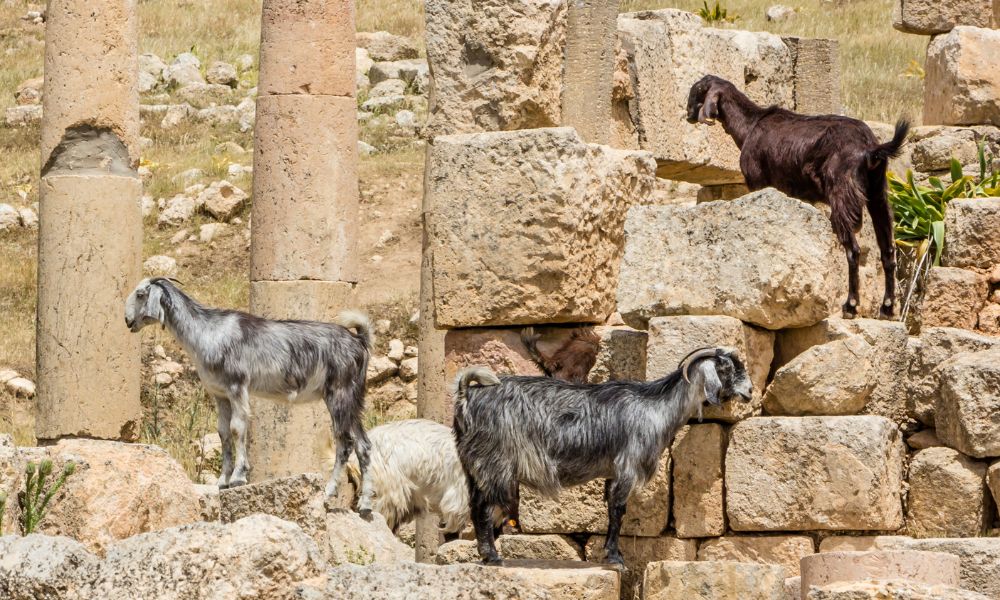I came across a viral clip that has been making the rounds recently, of what someone has referred to as a “monster” goat.
It was a very large goat, with a round, almost bulbous nose and snout, as well as a significant underbite.
Armed with my own goat breed knowledge, I instantly recognized it as a Damascus goat, popular in much of the Arab world for its appearance.
I wondered, though, how this look is achieved, and whether it’s done so through heavy inbreeding.
So, are Damascus goats inbred?
Like we do here in the West with unhealthily inbred canine breeds like pugs and bulldogs, the Damascus goat is bred not for function but for form.
That is not to say they aren’t used for meat and milk—just that they’re bred for their physical appearance.
Unfortunately, the goats suffer in the process and have materially reduced their quality of life as a result of their inbreeding.
Let’s look further into this.

Are Damascus goats real?
Yes, Damascus goats are real.
They are bred in many parts of the Arab world, and are also known as the Aleppo, Halep, Baladi, Damascene, Shami or Chami goats.
They are kept both as meat and dairy goats, but as purebred, aesthetic animals, they fetch hefty prices from wealthy people at auctions.
Damascus goats have heads that you almost may not recognize as a goat at first.
Their noses are huge and rounded, curving down towards their mouth.
Their lower jaw is set far back, giving them a significant underbite.
This makes it very hard for them to eat in the normal way goats eat.
Their ears also tend to be docked, and their horns polled, for the appearance.
All of this comes together to create a very strange-looking goat, which to many is hard to look at.
Why, exactly, are they bred this way, then?
Why are Damascus goats bred?
Originally, the Damascus goat was bred as a dairy breed.
They produce excellent quality milk at a very high yield, and did not always have the kinds of “deformities” we might recognize today.
So, at first, they were bred for the same reason any goat breed is bred.
Today, though, the reasons are more diverse.
Because it can be harder to get hold of a truly purebred Damascus goat, they are very expensive.
Thus, they become a symbol of status and wealth, in the same way purebred dogs are.
There are obviously spectrums of how inbred Damascus goats are. some of them, that are destined for showrooms and auctions, can have severe health problems.
Others are less clearly inbred, and live something approaching a regular goat life.
How are they bred, then?
How are Damascus goats bred?
Damascus goat pedigrees are a fairly exclusive club, today.
Only the wealthiest can afford to buy purebred Damascus goats, and they have become more and more popular, driving the price up.
They are descended from Nubian goats and are natives of Syria and other Near East countries.
They have been imported all over the world ever since, and has been continuously improved for meat and milk over the last forty years.
They are mixed with many other breeds today, as purebred Damascus goats often suffer from so many health issues that they do not survive long.
The biggest surprise about the Damascus goat is the cost—so how much do they go for?
How much does a Damascus goat cost?
The only simple answer is that it will vary a great deal.
It’s going to depend on weight, age, pedigree, and where you are in the world.
In the richest Arab auctions with purebred Damascus goats, you might find them selling for in excess of $1,500-$2000.
When crossbred with other species, they might for around $1,000, and still have many of the traits desired by breeders.
As with anything, though, it’s going to depend a lot.
There are markets where breeders claim the purest pedigrees, and their goats bring in as much as $10,000 at auction, with the right buyer there.
In general, though, you can get a Damascus goat for less than $2,000—still very pricey for a goat!
What is a Damascus goat mixed with?
Originally, Nubians were mixed with other native Near Eastern species to produce the Damascus goat.
Today, they are bred with many other species for different reasons.
Boer goats are some of the largest in the world, and Damascus goats are often bred with them for extra meat production.
They are also often bred with European breeds, such as Alpine goats, for higher quality milk yields.
It really only takes one or two generations of breeding with other breeds to massively reduce the physical traits which tend to cause these goats problems.
So, though they might look like something out of a science fiction story, Damascus goats are very real.
They have a lot of problems, too, and many are moving to have the breeding processes banned.
Whether you agree with inbreeding and pure breeding or not, it’s plain to see that Damascus goats suffer in life as a result of their inbreeding.
Even if that suffering is not overt, and excruciating, their quality of life is plainly reduced.

